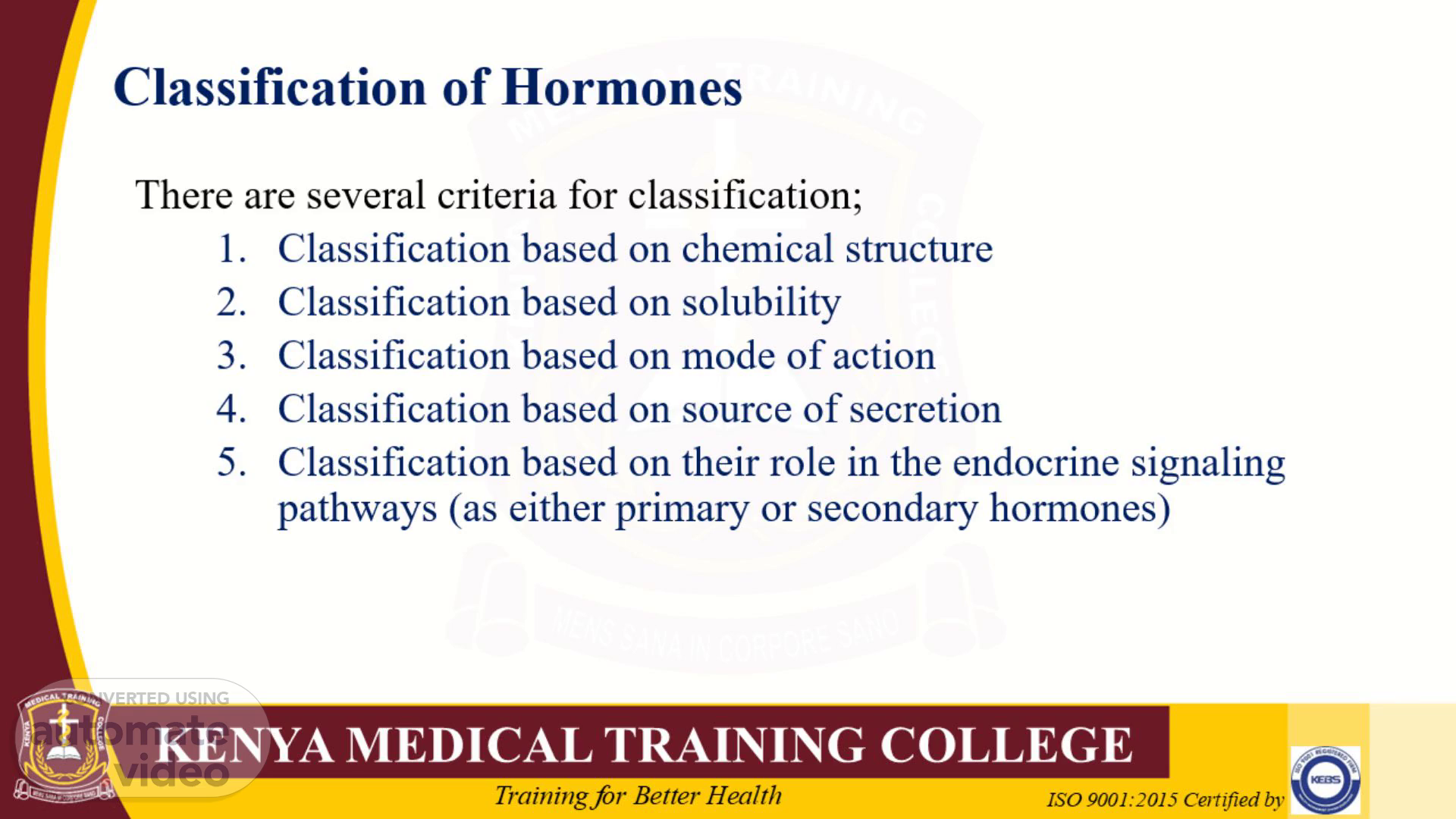Scene 1 (0s)
There are several criteria for classification; Classification based on chemical structure Classification based on solubility Classification based on mode of action Classification based on source of secretion Classification based on their role in the endocrine signaling pathways (as either primary or secondary hormones).
Scene 2 (17s)
Based on their chemical composition, hormones are classified into 4 main groups: 1. Steroid Hormones: Derived from cholesterol. They are lipid-soluble, allowing them to easily pass through cell membranes. Examples: Testosterone, estrogen, cortisol, aldosterone. 2. Peptide and Protein Hormones: Made up of chains of amino acids. Are water-soluble, requiring receptors on the cell surface for signaling. Examples: Growth hormone, insulin, glucagon, parathyroid hormone..
Scene 3 (41s)
[Virtual Presenter] Prostaglandins are hormone-like substances that primarily mediate inflammation Leukotrienes are signaling molecules that play a crucial role in the inflammatory response, particularly in allergic reactions and asthma.
Scene 4 (59s)
Classification Based on Solubility. Based on their solubility properties, hormones are classified as either; Water-Soluble Hormones - Mostly peptides and amine hormones. They cannot cross cell membranes easily and bind to receptors on the cell surface. Lipid-Soluble Hormones - Includes steroid hormones and thyroid hormones. They can easily pass through the cell membrane and interact with intracellular receptors..
Scene 5 (1m 17s)
[Virtual Presenter] Growth factors are a group of proteins that play a crucial role in regulating cell growth, proliferation, differentiation, and survival. They act as signaling molecules, e.g. fibroblast growth factors(FGFs), epidermal growth factors (EGFs) etc Cytokines are a diverse group of small proteins or peptides that play a crucial role in cell signaling and immune response, e.g. Ils, IFs, TNFs etc.
Scene 6 (1m 49s)
Classification Based on Source of Secretion. Based on their source, hormones are classified as either; Pituitary Hormones: Secreted by the pituitary gland, e.g., growth hormone (GH) and adrenocorticotropic hormone (ACTH). Thyroid Hormones: Secreted by the thyroid gland, e.g., thyroxine (T4) and triiodothyronine (T3). Adrenal Hormones: Secreted by the adrenal glands, e.g., cortisol, adrenaline, and aldosterone. Gonadal Hormones: Secreted by gonads, e.g., testosterone, estrogen, and progesterone. Pancreatic Hormones: Secreted by the pancreas, e.g., insulin and glucagon. Pineal Hormones: Secreted by the pineal gland, e.g., melatonin..
Scene 7 (2m 21s)
Classification based on their role in the endocrine signaling pathways.
Scene 8 (2m 51s)
Cont’d…. 2. Secondary (Tropic) hormones Also called tropic hormones, primarily act on other endocrine glands, prompting them to release primary hormones. Tropic hormones are often released by the pituitary gland and act as regulatory messengers Examples; Thyroid-Stimulating Hormone (TSH) – produced by the pituitary gland, it stimulates the thyroid gland to release thyroid hormones. Adrenocorticotropic Hormone (ACTH) – also from the pituitary, it stimulates the adrenal cortex to release cortisol. Luteinizing Hormone (LH) and Follicle-Stimulating Hormone (FSH) - pituitary hormones that stimulate the gonads to produce sex hormones like estrogen, progesterone, and testosterone..
Scene 9 (3m 17s)
Revision Questions. Outline the criteria for classification of hormones Classify hormones based on their chemical structure, giving relevant examples in each case.
